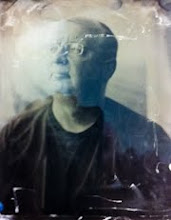Title: "Window on a Constructed Reality"
(click image to view larger)
I never cease to be surprised how often I embark on a little photographic walk, only to get no further than the back deck - completely stopped and engrossed by clouds. I find that clouds communicate in a language of emotion that is obscure and difficult to interpret. It is perhaps a language that reflects our own emotional state, where we find signs of hope, joy, foreboding, or fear in the clouds as a confirmation of what we feel at any given moment.
Alfred Stieglitz was the first to make a concerted series of cloud photographs as a study in abstraction, which he referred to as "Equivalents". The website for the Phillips Collection has this to say about the Stieglitz cloud images: "Stieglitz photographed clouds from 1922 into the thirties. A symbolist aesthetic underlies these images, which became increasingly abstract equivalents of his own experiences, thoughts, and emotions. The theory of equivalence had been the subject of much discussion at Gallery 291 during the teens, and it was infused by Kandinsky's ideas, especially the belief that colors, shapes, and lines reflect the inner, often emotive "vibrations of the soul." In his cloud photographs, which he termed Equivalents, Stieglitz emphasized pure abstraction, adhering to the modern ideas of equivalence, holding that abstract forms, lines, and colors could represent corresponding inner states, emotions and ideas".
I think one of the strongest draws that abstract images have on me is the emotional response I often feel viewing such an image. If one can get beyond the expectation of representation in art, or in the "treasure hunt" of finding something quasi-representational in an abstract image, what abstract art offers is a very personal, unique relationship with each viewer. An image that gives one viewer a feeling of joy may well invoke a different response in the next viewer. As an artist, I love making abstract images because they go hand in hand with experimentation. You start with no idea of the destination, and little accidents and happy circumstance guide the way to a completely unanticipated, satisfying image. What more could an artist want?


1 comment:
So beautifully stated, and so inspiring! Thank you for the link and the background, also.
Sometimes I wonder whether some of the difficulty in interpreting that language of emotion might be due to the limitations of verbal language itself - whether in making images like this one, that are so emotionally expressive and subtle, there's a pushing of the boundaries of language, a creation of a visual "name" for an experience that, by definition, can't be conveyed in words.
Post a Comment